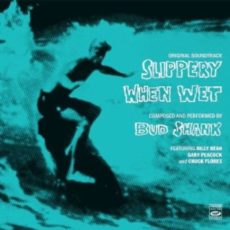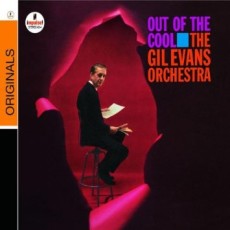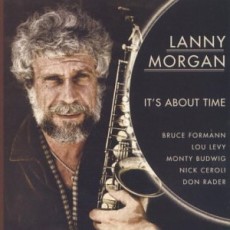
Daily Dose Of Jazz…
Bud Shank was born Clifford Everett Shank, Jr. on May 27, 1926 in Dayton, Ohio. He began with clarinet in Vandalia, Ohio, but had switched to saxophone before attending the University of North Carolina. While at UNC he was initiated into the Pi Kappa Alpha Fraternity.
In 1946 he worked with Charlie Barnet before working with Stan Kenton and the West Coast jazz scene. He also had a strong interest world music, playing Brazilian-influenced jazz with Laurindo Almeida in 1953–54, and in 1962 fusing jazz with Indian traditions in collaboration with Indian composer and sitar-player Ravi Shankar.
He spent the 1960s as a first-call studio musician in Hollywood and is also well known for the alto flute solo on the song California Dreamin’ recorded by The Mamas & the Papas in 1965. By 1974 Shank had joined with Ray Brown, Shelly Manne and Laurindo Almeida to form the group the L.A. Four, recording and touring extensively through 1982. He helped to popularize both Latin-flavored and chamber jazz music performing with orchestras as diverse as the Royal Philharmonic, the New American Orchestra, the Gerald Wilson Big Band, Stan Kenton’s Neophonic Orchestra, and Duke Ellington.
In 2005 he formed the Bud Shank Big Band in Los Angeles, California to celebrate the 40th anniversary of Stan Kenton’s Neophonic Orchestra.
A documentary film, Bud Shank “Against the Tide” Portrait of a Jazz Legend, was produced and directed by Graham Carter of Jazzed Media and released by Jazzed Media as a DVD and CD) in 2008. The film has been awarded 4 indie film awards including an Aurora Awards Gold.
Alto saxophonist Bud Shank, who also played tenor and baritone saxophone, passed away on April 2, 2009, of a pulmonary embolism at his home in Tucson, Arizona, one day after returning from San Diego, California, where he was recording a new album.
![]()
#preserving genius

Daily Dose Of Jazz…
Gil Evans came into this world on May 13, 1912 in Toronto, Ontario, Canada as Ian Ernest Gilmore Green. His name was changed to his stepfather’s Evans early in his life. His family moved to Stockton, California where he spent most of his youth.
Between 1941 and 1948, Evans worked as an arranger for the Claude Thornhill Orchestra. His basement apartment behind a New York City Chinese laundry became a meeting place for musicians looking to develop new musical styles outside of the dominant bebop style of the day that included the leading bebop performer Charlie Parker, Gerry Mulligan and John Carisi.
In 1948, Gil collaborated with Miles Davis, Mulligan and others to create a nonet utilizing French horns and tubas keeping the big sound with less cost. The Davis-led group was booked for a week at the Royal Roost as an intermission group on the bill with the Count Basie Orchestra. Subsequently, Capitol Records recorded 12 numbers at three sessions in 1949 and 1950 that were reissued on the 1957 Miles Davis LP titled Birth Of The Cool. He was also instrumental in contributing behind the scenes to Davis’ classic quintet albums of the 1960s.
From 1957 onwards Evans recorded albums under his own name. He brought tubist Bill Barber, trumpeter Louis Mucci along with im and featured soloists Lee Konitz, Jimmy Cleveland, Steve Lacy, Johnny Coles and Cannonball Adderley. By 1965 he was arranging the big band tracks on Kenny Burrell’s Guitar Forms album.
Evans’ influence by Latin, Brazilian and Spanish composers Manuel de Falla and Joaquin Rodrigo as well as German expat Kurt Weill led him to create arrangements that included two basses, using Richard Davis, Paul Chambers, Ron Carter, Ben Tucker and Milt Hinton on many of his recordings. He was prolific in his recording until he became discouraged by the commercial direction Verve Records was taking with his arrangements for Astrud Gilberto’s Look To The Rainbow, causing him to take a hiatus from music.
During this period he began listening to Jimi Hendrix at the suggestion of his wife. He became interested in scoring the music of the rock guitarist, put together another orchestra in the Seventies and began working with in the free jazz and jazz rock idioms. He eventually released an album of arrangements of Hendrix’s music with John Abercrombie and RyoKawasaki and his ensembles featured electric guitars and basses, like that of Jaco Pastorious, from that date forward.
He would go on to release Where Flamingos Fly in 1981 with Coles, Harry Lookofsky, Richard Davis and Jimmy Knepper, Howard Johnson, Don Preston and Billy Harper. He created his Monday Night Orchestra in 1983 that became a staple for five years at Sweet Basil Jazz Club in Greenwich Village. Members of the band were Lew Soloff, Hiram Bullock, David Sanborn, Mark Eagan and Tom “Bones” Malone and Gil Goldstein among others. He recorded a big band album of The Police songs with Sting collaborating with apprentice arranger Maria Schneider.
Gil won two Grammy awards, has four films to his credit and was inducted into the Down Beat Jazz Hall of Fame in 1986. He ha a catalogue of eighteen studio albums, 16 live albums, arranged fifteen albums for Miles Davis, Hal McKusick, Helen Merrill, Johnny Mathis, Macy Lutes, Don Elliott, Astrud Gilberto and Kenny Burrell.
Pianist, composer, arranger and bandleader Gil Evans, who played an important part in the development of cool, modal, free and fusion styles of jazz, passed away of peritonitis in Cuernavaca, Mexico at the age of 75 on March 20, 1988.
![]()
More Posts: piano

Daily Dose Of Jazz…
Sal Mosca was born April 27, 1927 in Mount Vernon, New York and studied piano with Lennie Tristano. After playing in the United States Army Band during World War II, he studied at the New York College of Music under the G.I. Bill.
Mosca began working with Lee Konitz in 1949 and also worked with Warne Marsh. He spent much of his career teaching and was relatively inactive since 1992; however, new CDs were released in 2004, 2005, and 2008.
Pianist Sal Mosca, who predominately performed in the cool jazz and post-bop genres, passed away on July 28, 2007 in White Plains, New York.
![]()
More Posts: piano

Daily Dose Of Jazz…
Rocco Scott LaFaro was born on April 3, 1936 in Irvington, New Jersey and grew up in Geneva, New York when his family moved there when he was five. His father played in many big bands and started him on the piano in elementary school. He switched to the bass clarinet in junior high school and the tenor saxophone in high school. It wasn’t until he was eighteen the summer before entering Ithaca College that he finally landed on the double bass.
During the early weeks of his sophomore year Scott joined Buddy Morrow and his big band, then left them in Los Angeles, California after a cross-country tour. Luck prevailed and he quickly found work and became known as one of the best of the young bassists. He studied under Red Mitchell who taught him how to pluck the strings with both the index and middle fingers independently. By 1958 he was spending much of the year in pianist/percussionist Victor Feldman’s band.
In 1959, after many gigs with Chet Baker, Stan Kenton, Cal Tjader, and Benny Goodman he moved back east and joined Bill Evans after his recent departure from Miles Davis. Along with Paul Motian and Evans that he developed and expanded the counter-melodic style that would come to characterize his playing. The trio committed to the idea of three equal voices in the trio, collectively working together organically towards a singular musical idea, often without the time being explicitly stated. LaFaro’s prodigious technique on bass made this concept possible.
By late 1960, LaFaro replaced Charlie Haden as Ornette Coleman’s bassist. In between gigs with Evans he played with Stan Getz and got a recruitment card of interest from Miles Davis. By summer they settled into the Village Vanguard in New York City for a two-week gig. The last day of the run, June 25, was recorded live in its entirely for eventual release as two albums, Sunday at the Village Vanguard and Waltz For Debby, both considered among the finest live jazz recordings of all time.
Double bassist Scott LaFaro passed away from an automobile accident on July 6, 1961 in Flint, New York four days after accompanying Stan Getz at the Newport Jazz Festival and ten days after the Village Vanguard recordings with the Bill Evans Trio.
Posthumously, in 2009, the University of North Texas Press published Jade Visions, a biography of Scott LaFaro by his sister Helene LaFaro-Fernandez. It includes an extensive discography of his recorded work. The same year Resonance Records released Pieces of Jade, the first album released featuring Scott as a bandleader. The album includes five selections recorded in New York City during 1961 that showcase LaFaro with pianist Don Friedman and drummer Pete LaRoca, as well as 22 minutes of LaFaro and Bill Evans practicing My Foolish Heart in late 1960 during a rehearsal.
![]()
More Posts: bass

Daily Dose Of Jazz…
Lanny Morgan was born March 30, 1934 in Des Moines, Iowa and raised in Los Angeles, California. In the 1950s he played with Charlie Barnet, Si Zentner, Terry Gibbs and Bob Florence.
He did a stint in the U.S. military and had to turn down an offer to play in the Stan Kenton orchestra. From 1960-65 he played in Maynard Ferguson’s orchestra after a few years in New York City Morgan returned to Los Angeles in 1969. There he did frequent studio work, performed sessions with Nancy Sinatra and Carmen McRae,
He was a member of Supersax and played in the big bands of Bill Berry, Bob Florence and Bill Holman. Alto saxophonist Lanny Morgan has chiefly been active on the West Coast jazz scene.
![]()
More Posts: saxophone


